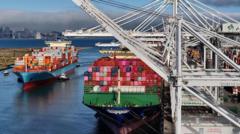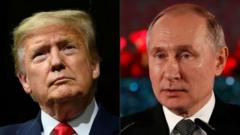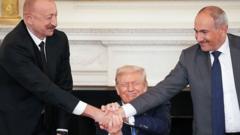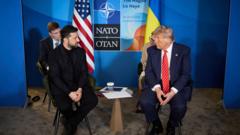The new tariffs, affecting over 90 countries, aim to boost U.S. manufacturing while pressuring countries to change their trade practices.
New Tariffs by Trump Target 90+ Countries Amid Global Economic Tensions

New Tariffs by Trump Target 90+ Countries Amid Global Economic Tensions
Donald Trump's latest trade measures are set to impact international relations and supply chains significantly.
Trump’s administration has implemented sweeping tariffs affecting more than 90 countries, marking a significant escalation in U.S. trade policies. Just before the negotiation deadline he set, Trump announced on his Truth Social platform the financial influx generated from these tariffs, asserting that billions are now flowing into the U.S. economy. His administration's goal is to bring jobs and manufacturing back to the U.S. while reshaping the global trading landscape, which he claims has been unfairly positioned against American interests.
On the same day, the president threatened to raise tariffs on certain imports. This includes a proposal for a 50% tariff on Indian goods unless the country ceases its oil purchases from Russia, highlighting how economic measures are intertwined with geopolitical stances. Additionally, Trump hinted at imposing a 100% tariff on foreign-made computer chips, aiming to incentivize tech companies to boost domestic production. His overarching strategy has been to narrow the trade deficit—the gap between what America imports versus what it exports.
The tariffs impose fees on U.S. importers who may pass these costs onto consumers. This recent round of tariffs is notably the highest average U.S. tariff rate seen in nearly a century and comes after a period of suspended rates due to market volatility and ongoing negotiations with various countries. Economic experts suggest that Trump has strategically targeted nations maintaining strong trade connections with China.
In Asia, economies like Laos and Myanmar are among the most affected, experiencing tariffs reaching up to 40%. Nonetheless, major stock markets across the region responded positively to the news, with indexes in Japan, Hong Kong, South Korea, and mainland China rising, while markets in India and Australia faced declines.
Some nations have successfully negotiated agreements to mitigate the impacts of these tariffs. Countries such as the UK, Japan, and South Korea will see lower tariff rates than those initially proposed. The EU, too, has come to terms with the U.S., agreeing to a 15% tariff framework on its goods. Meanwhile, Switzerland expressed concern as it faces a hefty 39% tariff, prompting an extraordinary meeting to seek resolution.
As Trump continues to make specific adjustments to tariffs on key trading partners like Canada and Mexico, his administration faces ongoing negotiations to reach satisfactory conclusions. Canada, for instance, recently had its tariff increase from 25% to 35%, a decision defended by Trump amid concerns over drug trafficking.
The political implications of these tariffs extend to relations with Russia as Trump has suggested additional sanctions could emerge if there are no signs of resolution regarding the conflict in Ukraine. Analysts are wary that these strategies could further complicate U.S. relationships with other nations reluctant to sever ties with Russia. The economic landscape is shifting, and experts predict that analyzing the long-term impacts of these tariffs will become more feasible in the coming months. As businesses grapple with these changes, Trump’s broader trade agenda continues to unfold, with far-reaching effects anticipated globally.
On the same day, the president threatened to raise tariffs on certain imports. This includes a proposal for a 50% tariff on Indian goods unless the country ceases its oil purchases from Russia, highlighting how economic measures are intertwined with geopolitical stances. Additionally, Trump hinted at imposing a 100% tariff on foreign-made computer chips, aiming to incentivize tech companies to boost domestic production. His overarching strategy has been to narrow the trade deficit—the gap between what America imports versus what it exports.
The tariffs impose fees on U.S. importers who may pass these costs onto consumers. This recent round of tariffs is notably the highest average U.S. tariff rate seen in nearly a century and comes after a period of suspended rates due to market volatility and ongoing negotiations with various countries. Economic experts suggest that Trump has strategically targeted nations maintaining strong trade connections with China.
In Asia, economies like Laos and Myanmar are among the most affected, experiencing tariffs reaching up to 40%. Nonetheless, major stock markets across the region responded positively to the news, with indexes in Japan, Hong Kong, South Korea, and mainland China rising, while markets in India and Australia faced declines.
Some nations have successfully negotiated agreements to mitigate the impacts of these tariffs. Countries such as the UK, Japan, and South Korea will see lower tariff rates than those initially proposed. The EU, too, has come to terms with the U.S., agreeing to a 15% tariff framework on its goods. Meanwhile, Switzerland expressed concern as it faces a hefty 39% tariff, prompting an extraordinary meeting to seek resolution.
As Trump continues to make specific adjustments to tariffs on key trading partners like Canada and Mexico, his administration faces ongoing negotiations to reach satisfactory conclusions. Canada, for instance, recently had its tariff increase from 25% to 35%, a decision defended by Trump amid concerns over drug trafficking.
The political implications of these tariffs extend to relations with Russia as Trump has suggested additional sanctions could emerge if there are no signs of resolution regarding the conflict in Ukraine. Analysts are wary that these strategies could further complicate U.S. relationships with other nations reluctant to sever ties with Russia. The economic landscape is shifting, and experts predict that analyzing the long-term impacts of these tariffs will become more feasible in the coming months. As businesses grapple with these changes, Trump’s broader trade agenda continues to unfold, with far-reaching effects anticipated globally.


















